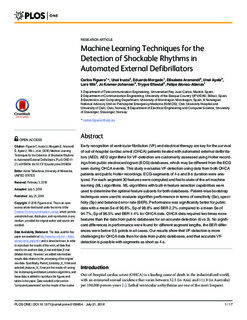| dc.contributor.author | Figuera, Carlos | |
| dc.contributor.author | Irusta, Unai | |
| dc.contributor.author | Morgado, Eduardo | |
| dc.contributor.author | Aramendi, Elisabete | |
| dc.contributor.author | Ayala, Unai | |
| dc.contributor.author | Wik, Lars | |
| dc.contributor.author | Kramer-Johansen, Jo | |
| dc.contributor.author | Eftestøl, Trygve | |
| dc.contributor.author | Alonso-Atienza, Felipe | |
| dc.date.accessioned | 2017-05-30T11:53:35Z | |
| dc.date.available | 2017-05-30T11:53:35Z | |
| dc.date.issued | 2016-07 | |
| dc.identifier.citation | Figuera, C. (2016) Machine learning techniques for the detection of shockable rhythms in automated external defibrillators. Plos One, 11(7): e0159654 | nb_NO |
| dc.identifier.uri | http://hdl.handle.net/11250/2443860 | |
| dc.description.abstract | Early recognition of ventricular fibrillation (VF) and electrical therapy are key for the survival of out-of-hospital cardiac arrest (OHCA) patients treated with automated external defibrillators (AED). AED algorithms for VF-detection are customarily assessed using Holter recordings from public electrocardiogram (ECG) databases, which may be different from the ECG seen during OHCA events. This study evaluates VF-detection using data from both OHCA patients and public Holter recordings. ECG-segments of 4-s and 8-s duration were analyzed. For each segment 30 features were computed and fed to state of the art machine learning (ML) algorithms. ML-algorithms with built-in feature selection capabilities were used to determine the optimal feature subsets for both databases. Patient-wise bootstrap techniques were used to evaluate algorithm performance in terms of sensitivity (Se), specificity (Sp) and balanced error rate (BER). Performance was significantly better for public data with a mean Se of 96.6%, Sp of 98.8% and BER 2.2% compared to a mean Se of 94.7%, Sp of 96.5%and BER 4.4% for OHCA data. OHCA data required two times more features than the data from public databases for an accurate detection (6 vs 3). No significant differences in performance were found for different segment lengths, the BER differences were below 0.5-points in all cases. Our results show that VF-detection is more challenging for OHCA data than for data from public databases, and that accurate VFdetection is possible with segments as short as 4-s. | nb_NO |
| dc.language.iso | eng | nb_NO |
| dc.publisher | Public Library of Science | nb_NO |
| dc.rights | Navngivelse 4.0 Internasjonal | * |
| dc.rights.uri | http://creativecommons.org/licenses/by/4.0/deed.no | * |
| dc.subject | ventricular fibrillation (VF) | nb_NO |
| dc.subject | out-of-hospital cardiac arrest | nb_NO |
| dc.subject | hjerteinfarkt | nb_NO |
| dc.subject | automated external defibrillators | nb_NO |
| dc.subject | automatisert defibrillator | nb_NO |
| dc.title | Machine learning techniques for the detection of shockable rhythms in automated external defibrillators | nb_NO |
| dc.type | Journal article | nb_NO |
| dc.type | Peer reviewed | nb_NO |
| dc.description.version | publishedVersion | nb_NO |
| dc.rights.holder | © 2016 Figuera et al. | nb_NO |
| dc.subject.nsi | VDP::Medisinske Fag: 700::Klinisk medisinske fag: 750::Kardiologi: 771 | nb_NO |
| dc.subject.nsi | VDP::Teknologi: 500::Informasjons- og kommunikasjonsteknologi: 550 | nb_NO |
| dc.source.volume | 11 | nb_NO |
| dc.source.journal | Plos One | nb_NO |
| dc.source.issue | 7 | nb_NO |
| dc.identifier.doi | 10.1371/journal.pone.0159654 | |

